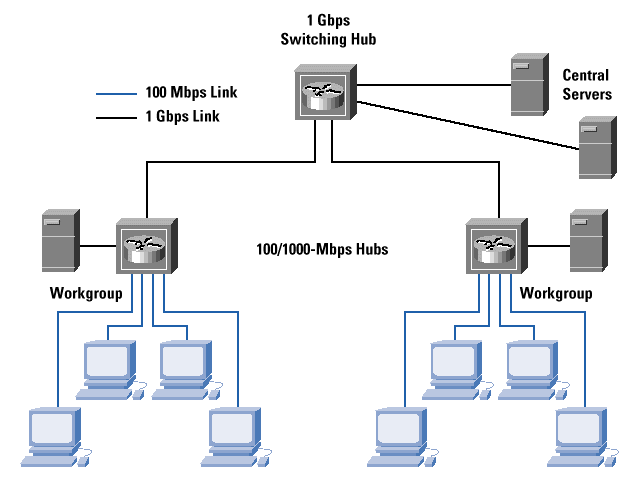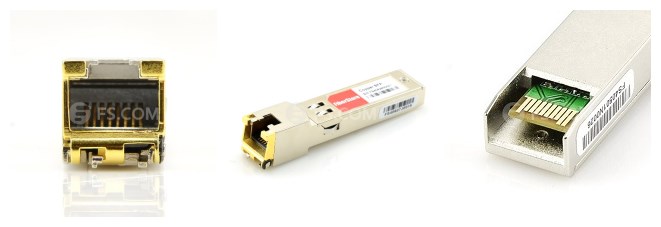1000Base-T SFP Module for Gigabit Ethernet
The Gigabit Ethernet technology is an extension of the 10/100-Mbps Ethernet standard. Gigabit Ethernet provides a raw data bandwidth of 1000 Mbps while maintaining full compatibility with the installed base of over 70 million Ethernet nodes. Gigabit Ethernet includes both full- and half-duplex operating modes. A Gigabit Ethernet is imperative for two reasons: faster systems and faster backbones. Gigabit Ethernet has the potential for low-cost products, freedom of choice in selecting the products, interoperability, and backward compatibility. Gigabit Ethernet supports existing applications, network operating systems, and network management; it requires a minimal learning curve for Ethernet network administrators and users. These investment preservation and risk minimization aspects are what make Gigabit Ethernet so attractive. With the development of Ethernet systems and the growing capacity of modern silicon technology, embedded communication networks are playing an increasingly important role in embedded and safety critical systems.

A known type of data communication device is a small form factor pluggable (SFP) module. Typically, the SFP module plugs into an interface slot in a circuit board populated with other communication devices used in an Ethernet-based system. The SFP module includes a second serial interface,interconnected with the circuit board slot, and a first serial interface, coupled to a serial link, such as a copper or fiber link, for communicating with remote link partners. The serial link, coupled with the first serial interface, may be a 10/100/1000 Base-T copper link, or a fiber link, for example. The SFP module also offers several significant advantages over its predecessor, the GBIC (Gigabit Interface Converter), including lower cost, lower power, and smaller size. Thus, with the SFP form factor, fiber Gigabit systems may be developed featuring similar port densities as copper-only systems using RJ-45 connectors.
The SFP transceiver MultiSource Agreements (MSA) document puts forward a specification for the development of optical SFP modules based on IEEE 802.3z, the Gigabit Ethernet Standard. Specifically, the MSA calls out 1000Base-X Physical Coding Sub-layer (PCS) which supports full-duplex binary transmission at 1.25 Gbps over two copper wire-pair SerDes (Serializer/Deserializer). Transmission coding is based on the ANSI Fiber Channel 8B/10B encoding scheme.
1000Base-X makes no provision for running at slower speeds. Thus, network device ports utilizing SFPs are dedicated to operating on fiber links at speeds of 1000 Mbps. However, more than 85% of office space inside buildings is category 5 copper. Thus, ports designed to use optical SFPs can not make use of this existing cabling.
For example, a customer may require a network device, such as a router, having both optical ports for long distance connections and RJ-45 copper ports for connecting to local devices. It is often the case that not all optical ports provided on a router are needed at a given time. However, with conventional SFPs these optical ports cannot be utilized to connect with local devices connected by standard copper cabling or operating at speeds lower than 1000 Mbps. But with a 1000BASE-T copper SFP transceiver, the customer could use their existing copper cabling infrastructure instead of replacing the infrastructure. Here are two good examples of 1000BASE-T copper SFP transceivers, the Finisar FCLF-8521-3 compatible 1000BASE-T SFP copper transceiver and Cisco Linksys MGBT1 compatible 1000BASE-T SFP copper transceiver from FS.COM. Both of them are designed for 100m reach over Cat 5 UTP cable with RJ-45 interface and support max data rate of 1000Mbps.

The 1000BASE-T copper SFP transceiver offers a flexible and simple method to be installed into SFP MSA compliant ports at any time with no interruption of the host equipment operation. It enables for seamless integration of fiber with copper LAN connections wherever SFP interface slots can be found. Such system is economical, it saves time, offers flexibility and eliminates the necessity for replacing entire devices once the customers have to change or upgrade fiber connections and you will benefit so much from it.
